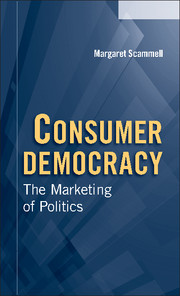Book contents
- Frontmatter
- Dedication
- Contents
- List of Tables, Figures, and Images
- Acknowledgments
- Preface: The U.S. Presidential Election of 2012
- Introduction
- 1 Political Marketing
- 2 Political Marketers
- 3 Political Brands
- 4 George W. Bush
- 5 Campaigning Effects
- 6 Citizen Consumers, Political Marketing, and Democracy
- Conclusion
- References
- Index
Preface: The U.S. Presidential Election of 2012
Published online by Cambridge University Press: 05 June 2014
- Frontmatter
- Dedication
- Contents
- List of Tables, Figures, and Images
- Acknowledgments
- Preface: The U.S. Presidential Election of 2012
- Introduction
- 1 Political Marketing
- 2 Political Marketers
- 3 Political Brands
- 4 George W. Bush
- 5 Campaigning Effects
- 6 Citizen Consumers, Political Marketing, and Democracy
- Conclusion
- References
- Index
Summary
Preface: The U.S. Presidential Election of 2012
What did we learn from the 2012 U.S. presidential election? Its fascination lies partly in the difficulty of characterizing it easily. It presents us with an array of seemingly contradictory verdicts, many of which have at least surface plausibility.
On the one hand, it was the nothing-much-happened election; it was the most costly race in history that ended up delivering the status quo in the White House and relatively minimal change on Capitol Hill. On the other, it marked a watershed result that may cast the Republicans into the wilderness, ideologically alienated from women, nonwhites, youth, and the “new Americans” from Latin America and Asia. On the one hand, it was a race of tight margins; just a few hundred thousand votes in four key states separated former governor Mitt Romney from the White House. The real decider was not the Republican “value set” but their organizational failures in the ground wars; they were outfought and outthought on the data-driven turnout operations in the places where it mattered (Stutts, 2012). On the other hand, it was an “ass-whuppin’,” in the words of Democratic consultants Carville and Greenberg (2012a), in which the Republicans were crushed in the Electoral College, fell short in almost all the main battleground states, and fared badly with virtually all demographic segments of society apart from white men and those over forty-five.
- Type
- Chapter
- Information
- Consumer DemocracyThe Marketing of Politics, pp. xv - xxivPublisher: Cambridge University PressPrint publication year: 2014



